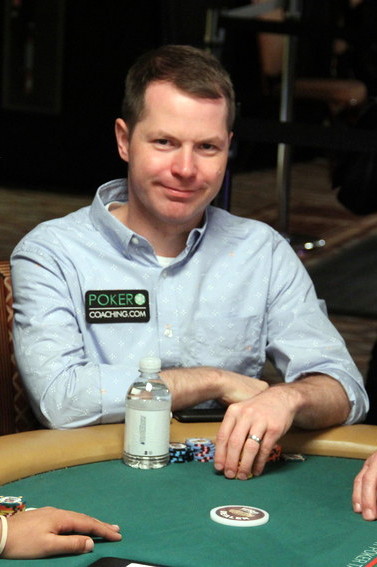






Being A Bullyby Jonathan Little | Published: Mar 06, 2024 |
|
|
 If you want to increase your poker skills and learn to crush the games, check out Jonathan Little’s elite training site at PokerCoaching.com/CardPlayer.
If you want to increase your poker skills and learn to crush the games, check out Jonathan Little’s elite training site at PokerCoaching.com/CardPlayer.
I was recently told about an interesting situation from a $2-$4 live no-limit cash game that demonstrates how to take advantage of weak, straightforward players who telegraph their hand’s strength with their bet sizes.
With $600 effective stacks, a player from middle position limped, as did the cutoff. Our Hero raised to $24 from the button with J 10
10 .
.
While I am fine with raising this decently-strong hand that has good post-flop playability from the button, both calling and raising larger to $32 are also reasonable options.
Calling keeps the pot small, amplifying your post-flop advantage (assuming you play well) and raising larger allows you to pick up the preflop pot with no contest more often. When you make it between $16 and $24, you will find that you almost never win the pot preflop, meaning you will often have to flop well to have a good chance to win the pot.
Only the cutoff called Hero’s $24 raise. The flop came A Q
Q 8
8 , giving Hero a flush draw and double-gutshot straight draw. The cutoff led for $20 into the $54 pot.
, giving Hero a flush draw and double-gutshot straight draw. The cutoff led for $20 into the $54 pot.
Most of the time when someone leads on a flop that should be excellent for the preflop raiser’s range, they usually have some sort of marginal made hand or a junky draw. Given Hero’s J 10
10 makes it less likely that the opponent has a draw, he likely has a weak ace that is betting to try to “find out where it stands”.
makes it less likely that the opponent has a draw, he likely has a weak ace that is betting to try to “find out where it stands”.
If you think the opponent will fold an ace to a flop raise, then raising large, perhaps to $100, has a lot of merit. If you think your opponent will never fold top pair, calling with the strong draw makes more sense. That said, when you have a premium draw, taking the aggressive route is rarely wrong because even when your opponent calls, you will still win the pot roughly 50% of the time.
Hero called. The turn was the 10 . Both players checked.
. Both players checked.
When checked to on the turn, Hero should assume his middle pair is rarely the best hand, although it will be from time to time when he is against a junky flush draw like 7 6
6 . The real question is whether or not the opponent will fold an ace to a turn plus river bet.
. The real question is whether or not the opponent will fold an ace to a turn plus river bet.
In my experience, they will make a big fold if you bet large enough. However, if you think your opponent plans to call down once he checks the turn, semi-bluffing makes no sense.
The river was the Q . The opponent bet $30 into the $94 pot.
. The opponent bet $30 into the $94 pot.
At this point, it is highly unlikely that Hero has the best hand. The opponent will have an ace or queen almost every time. In his post-hand analysis to me, Hero mentioned that he has seen his opponent bet small on the river twice with marginal value hands and large on the river once with the nuts. This made Hero think the opponent was much more likely to have an ace than a queen (or a better made hand).
Hero bluff-raised to $120.
I like raising the river more than I like calling. When you lose to all the marginal made hands in your opponent’s range and you think most of your opponent’s range is marginal made hands, calling makes no sense.
Hero’s only options are to raise or fold. Hero must now assess whether or not the opponent will fold an ace to a raise. Some players will always call while others will always fold. If you are confident your specific opponent will rarely call with an ace, raising makes a lot of sense.
I like Hero’s $120 raise size. It is a substantial amount that will often result in the opponent folding.
The opponent grumbled for a minute about how lucky Hero was to catch his queen on the river before folding A-2 face-up. Nice hand! ♠
If you want to quickly plug the 25 most common mistakes I see my students make, I put together a course called The 25 Biggest Leaks and How to Fix Them. This course is completely free inside Card Player Poker School!
When you join the Card Player Poker School (it’s free to join), you’ll also get:
 Jonathan Little is a two-time WPT winner and the 2024 PokerGO Cup champion with nearly $9 million million in live tournament earnings, best-selling author of 15 educational poker books, and 2019 GPI Poker Personality of the Year. If you want to increase your poker skills and learn to crush the games, check out his training site at PokerCoaching.com/cardplayer.
Jonathan Little is a two-time WPT winner and the 2024 PokerGO Cup champion with nearly $9 million million in live tournament earnings, best-selling author of 15 educational poker books, and 2019 GPI Poker Personality of the Year. If you want to increase your poker skills and learn to crush the games, check out his training site at PokerCoaching.com/cardplayer.